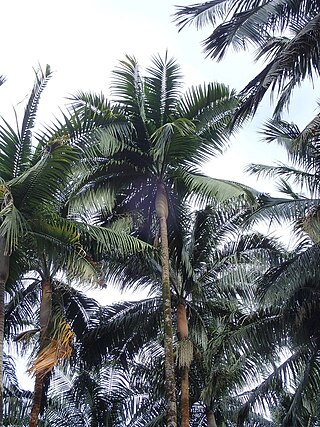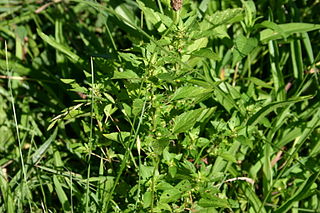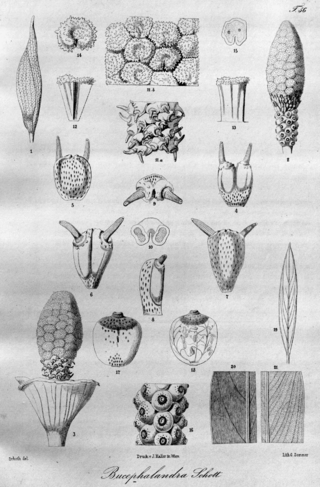
Aleurites is a small genus of arborescent flowering plants in the Euphorbiaceae, first described as a genus in 1776. It is native to China, the Indian Subcontinent, Southeast Asia, Papuasia, and Queensland. It is also reportedly naturalized on various islands as well as scattered locations in Africa, South America, and Florida.

Plant reproductive morphology is the study of the physical form and structure of those parts of plants directly or indirectly concerned with sexual reproduction.

Gynoecium is most commonly used as a collective term for the parts of a flower that produce ovules and ultimately develop into the fruit and seeds. The gynoecium is the innermost whorl of a flower; it consists of pistils and is typically surrounded by the pollen-producing reproductive organs, the stamens, collectively called the androecium. The gynoecium is often referred to as the "female" portion of the flower, although rather than directly producing female gametes, the gynoecium produces megaspores, each of which develops into a female gametophyte which then produces egg cells.

Chamaesyce is a subgenus of plants in the family Euphorbiaceae. Recent phylogenetic studies have shown that Chamaesyce is deeply nested within the broader Euphorbia. Specifically, Chamaesyce is very closely related to plants like Euphorbia pulcherrima, the popular poinsettia. Currently, all species have now been reclassified as species of Euphorbia. Specifically, this group now belongs to Euphorbia subgenus Chamaesyce section Anisophyllum. Taxonomically speaking, Chamaesyce is considered a synonym of Euphorbia.

Acanthophoenix is a genus of flowering plants in the palm family from the Mascarene Islands in the Indian Ocean, where they are commonly called palmiste rouge. A genus long in flux, three species are currently recognized, though unsustainable levels of harvesting for their edible palm hearts have brought them all to near extinction in habitat. They are closely related to the Tectiphiala and Deckenia genera, differing in the shape of the staminate flower. The name combines the Greek words for "thorn" and "date palm".

Lepiderema is a genus of eight species of trees in the lychee family Sapindaceae native to New Guinea and eastern Australia, plus one more from Queensland that is yet to be formally described. The type species is Lepiderema papuana.
This page provides a glossary of plant morphology. Botanists and other biologists who study plant morphology use a number of different terms to classify and identify plant organs and parts that can be observed using no more than a handheld magnifying lens. This page provides help in understanding the numerous other pages describing plants by their various taxa. The accompanying page—Plant morphology—provides an overview of the science of the external form of plants. There is also an alphabetical list: Glossary of botanical terms. In contrast, this page deals with botanical terms in a systematic manner, with some illustrations, and organized by plant anatomy and function in plant physiology.

Acalypha rhomboidea is a plant in the spurge family, Euphorbiaceae.
This glossary of botanical terms is a list of definitions of terms and concepts relevant to botany and plants in general. Terms of plant morphology are included here as well as at the more specific Glossary of plant morphology and Glossary of leaf morphology. For other related terms, see Glossary of phytopathology, Glossary of lichen terms, and List of Latin and Greek words commonly used in systematic names.

Bucephalandra is a genus of flowering plants in the family Araceae. There are 30 species of Bucephalandra which have been discovered in Borneo and have been formally described by S.Y. Wong and P.C. Boyce. Most of the species are found in Borneo. Bucephalandra are usually found growing as dense mats over stones or rocks in streams or rivers in moist tropical forest.
Syndiclis is a genus of flowering plants in the family Lauraceae. It contains ten species, which are native to China, Vietnam and Hainan, and Bhutan.

Olmediella is a monotypic genus of flowering plants in the family Salicaceae. It consists of one species of trees: Olmediella betschleriana, which is native to Central America. Formerly placed in the heterogeneous family Flacourtiaceae, Olmediella is now classified in Salicaceae, along with close relatives Bennettiodendron, Carrierea, Idesia, Itoa, Macrohasseltia, Poliothyrsis, and even the willows (Salix) and cottonwoods (Populus) themselves.

Goldbachia is a genus of flowering plants belonging to the family Brassicaceae.

Aporosa octandra is a species of plant in the family Phyllanthaceae found from Queensland and New Guinea to Indonesia, China and India. It is a highly variable plant with 4 named varieties. Its wood is used in construction and to make implements, its fruit is edible. The Karbi people of Assam use the plant for dyeing.

Itoa orientalis is a species of flowering plants belonging to the family Salicaceae. An evergreen tree from China and Vietnam, and cultivated as an ornamental tree.
Gibbsia is a genus of flowering plants belonging to the family Urticaceae.

Mollia is a genus of flowering plants belonging to the family Malvaceae. It is within the Grewioideae subfamily, and the Grewieae tribe.

Goethalsia is a monotypic genus of flowering plants belonging to the family Malvaceae. It only contains one species, Goethalsia meiantha(Donn.Sm.) Burret It is within the Grewioideae subfamily.

Pometia is a genus of 2 species of rainforest trees, constituting part of the plant family Sapindaceae.

In botany, floral morphology is the study of the diversity of forms and structures presented by the flower, which, by definition, is a branch of limited growth that bears the modified leaves responsible for reproduction and protection of the gametes, called floral pieces.
















